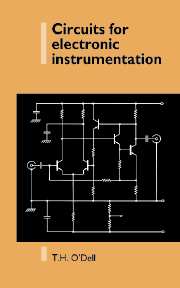Book contents
- Frontmatter
- Contents
- Preface
- 1 Circuits for electronic instrumentation
- 2 Sampling pulse generator circuits
- 3 Sample and hold circuits
- 4 Comparator circuits
- 5 Probes and input circuits
- 6 Wide-band amplifier circuits
- 7 Waveform generator circuits
- 8 Switched capacitor circuits
- 9 Phase locked loop circuits
- 10 Low noise circuits
- Name index
- Subject index
2 - Sampling pulse generator circuits
Published online by Cambridge University Press: 05 June 2012
- Frontmatter
- Contents
- Preface
- 1 Circuits for electronic instrumentation
- 2 Sampling pulse generator circuits
- 3 Sample and hold circuits
- 4 Comparator circuits
- 5 Probes and input circuits
- 6 Wide-band amplifier circuits
- 7 Waveform generator circuits
- 8 Switched capacitor circuits
- 9 Phase locked loop circuits
- 10 Low noise circuits
- Name index
- Subject index
Summary
Pulse width and rise time
The problems considered in this chapter concern devices and circuits which can produce very short pulses. The sampling pulse generators, found in the most advanced sampling and digitising oscilloscopes, may produce pulses as short as 50 ps. The first point to consider, however, is the shape of the pulse itself. This might seem to be a very trivial matter, but it does hold the key to good pulse generator circuit design.
Fig. 2.1 illustrates what is meant. Every real pulse has finite rise and fall times, τr and τf in Fig. 2.1, as well as a pulse width, τ. The rise and fall times are traditionally taken between the times at which the level is at 10% and 90% of the pulse amplitude, A. For the sampling pulse generator, the pulse width, τ, is best taken as shown in Fig. 2.1: the time that the pulse lies above 90% of its maximum amplitude.
What is important here is that a well-designed pulse generator circuit will always have some clearly identifiable part that defines the pulse width. For example, this could be a length of transmission line or a CR time constant. Whatever defines the pulse width, it must have negligible effect upon the rise and fall times, and these both need to be made as short as possible. In the case of a sampling pulse generator, where a very small pulse width is of primary concern, it is vital to obtain very short rise and fall times.
- Type
- Chapter
- Information
- Circuits for Electronic Instrumentation , pp. 12 - 26Publisher: Cambridge University PressPrint publication year: 1991



